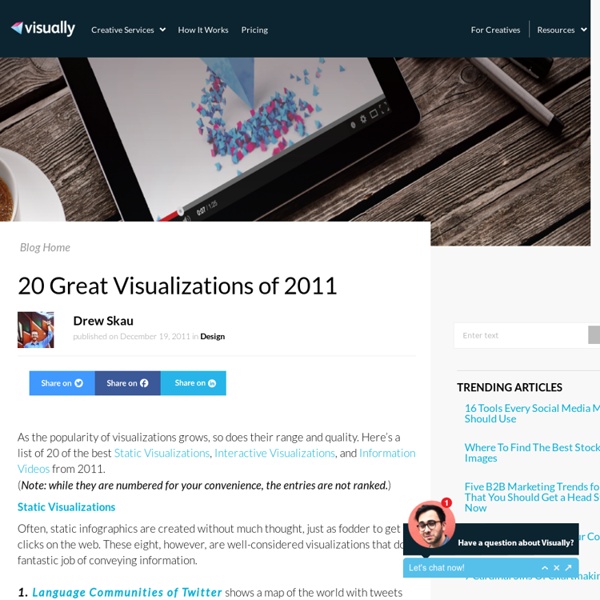What's An Average Day on Facebook? [Infographic]
Did you know that American Internet users spend more time on Facebook than any other site? Not only is it the site with the second-largest U.S. audience, just behind Google, but it far surpasses every other site in the top 10 of most popular websites, according to data from Nielsen, with the average user spending more than 7 hours and 45 minutes each month on the site. No wonder it's a popular site for marketing and engaging with consumers. So, what does the average user do on Facebook each day? Here's a glimpse into Facebook habits courtesy of creative agency JESS3. How does your Facebook use stack up to these numbers? Connect: Authored by: Tiffany Monhollon Tiffany Monhollon writes about local online marketing, social media, web presence optimization and small business success as the lead blogger for ReachLocal. See complete profile
Data Visualization Blog | Visual.ly
Content alone does not make a great video; you need a great video design that make a visual statement combining design and data visualization to deliver a story. Designers often get a little excited and put too much fancy design to fill in the space. The best content marketing brands are the ones that know how use content to drive conversions and pushing the boundaries. Keep in mind, quality = attention span. “Bosch Envision 360 VR” – Bosch Auto Parts The new Bosch Envision windshield wiper blade sharpens night visibility and offers extreme weather safety. “Morton Salt Girl’s 100th Birthday” – Morton Salt For 100 years, we’ve celebrated life’s moments with the Morton Salt Girl — from birthdays to holidays to the everyday. “Autodesk Forge” – Autodesk Autodesk came to Visually to help translate the features of their new Forge platform into vignettes with fantasy machinery... keep reading
20 Websites with Original, Non-Standard Geometry
Geometric shapes are widely used as design and framing elements, navigation components or as a way of drawing users’ attention to certain parts of a website. The most popular geometric elements in web design are obviously rectangles and circles. But what about using other geometric figures? In this showcase we will show you that not only simple shapes and figures can be used for designing a website effectively, but as you will find below, a number of sites that use unusual and complex shapes as a way of enhancing their web design. Tapmates Inc Networked Insignts Cinqfinch Badr Olivers Fusion Room Truly Design Neo Lab Ezorzi Square Factor Santi Urso Jessica Caldwell Cappen Rally Interactive Anet Design Apicula Triangle Char & Bar Web Species Poncho8
Cool Infographics - Blog
If you’re located near Washington, DC or Fort Lauderdale, FL, I’ll be there next week! I have a packed schedule of both public and private events, so check your schedule and join me if you can! I’ll be presenting about data visualization and infographics, and signing books. I look forward to meeting you! Washington DC Monday, Feb 10th, 3:00pm CBO (Congressional Budget Office) - private event and book signing Tuesday, Feb 11th, 12:00pm, Noblis Tech Tuesday - private event and book signing Tuesday, Feb 11th, 6:30pm, Data Visualization DC Meetup group - PUBLIC presentation, book signing and data drinks! Register here: Wednesday, Feb 12th, Greater Washington Board of Trade Morning Star Speaker Series - PUBLIC event * Discount for Cool Infographics readers - use the code “Cool*Infographics” at checkout to get the member price even if you’re a non-member ($25 discount)! Miami, FL Fort Lauderdale, FL
Booz & Company - A global management and strategy consulting firm
Why Do People Follow Brands? [INFOGRAPHIC]
The Centre for Independent Studies
The infographic résumé
Standing out in a sea of seemingly identical job applicants can provide quite the challenge, but crafting a résumé with a dash of pizazz could be your ticket to employment. MostCreativeResumes.com features a collection of clever infographic-themed résumés that effectively repurpose the data visualization trend for the job seeking set. Why stick to a page filled with Times New Roman when a pie chart could spice it up? Full collection at MostCreativeResumes. Find a job.
Infographics : le point sur le QR Code
Lorsqu’on fait des recherches sur internet, il est assez difficile de trouver des informations sur les usages du QR Code. Une étude de l’institut MMD data nous avait permis de montrer l’importante utilisation du QR Code au Japon. Aujourd’hui voici une infographie qui nous donne quelques informations (à prendre avec des pincettes) sur la notoriété et l’usage du QR Code. Cette infographie a été réalisée à partir d’une étude dont l’échantillon ne semble pas être représentatif d’une population (41 % de répondants hommes, 58 % femmes, la plupart ayant entre 25 et 54 ans et vivant aux États-Unis). Parmi les chiffres, nous en avons relevé trois : - 28 % des personnes interrogées ont déjà scanné un QR Code avec leur smartphone - Près de 10 % des personnes interrogées scannent des QR Code au moins une fois par mois - 12 % des personnes interrogées ont déjà scanné un QR Code à partir d’une télévision (une pratique qui est très faible en France Cliquez ici pour découvrir l’infographie complète



